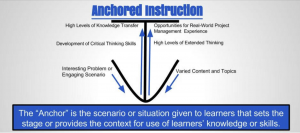Anchored Instruction Model
While there have been many contributors to the paradigm of anchored instruction, John Bransford is considered the leader of this framework. Through the Cognition & Technology Group at Vanderbilt University, he facilitated the idea of combining rich, meaningful contexts with technology-based learning.
Anchored instruction is often considered to be a form of situated learning, which connects prior knowledge to authentic situations. Students use the context provided to apply their knowledge of a particular idea, which furthers develops their understanding of a topic. The situations are realistic in order to assist students in making connections. In anchored instruction, the task itself is considered the anchor, or the idea around which all understanding will revolve. This usually comes in the form of a story with a problem that needs to be solved. Anchoring refers to the connection between the story and the real-life situation.

The anchored activity not only promotes connections between the content and real-life but also between subject areas. Students can reflect on how other domains related to the learning activity, what knowledge can be integrated to assist in understanding. As anchored instruction promotes problem-solving, students are able to see how the learning is meaningful.
See also: Cognitive Apprenticeship
A story or an adventure is often used as the ‘anchor’ for an activity. This helps capture the interest of the students and motivate them to solve the problem. The activity itself usually includes all of the information necessary to find a resolution. Not only does this make it more manageable for those who work in environments with limited resources, the data provided is also used in scaffolded instruction.
Anchored instruction is similar to two other learning styles: case-based and problem-based learning. Case-based learning is a slight extension of anchored instruction; students elaborate on the texts and videos with class discussions. Alternatively, problem-based learning focuses on expanding one’s thinking beyond the ideas taught in class; students would continue to research the topic online.
See also: Gagne’s Nine Events of Instruction
Anchored instruction stages
- Introduction: Stage objectives:
- Engage or interest students
- Sets the stage or contest for the problems students should address
- Familiarization: Stage objectives:
- Get all learners on the same page
- Transfer ownership of the problem to learners
- Learners become responsible for concept application
- Expansion: Stage objectives:
- Opportunity for learners to research their topic and ideas
- Plan: Stage objectives:
- Learners plan how to address the problem
- Transfer: Stage objectives:
- Learners identify how concepts are applied elsewhere
- Share: Stage objectives:
- Learners share their experiences
Anchored instruction components
There are four essential components to anchored instruction:
- Meaningful context: videos provide a large-scale visualization of real issues in the field as well as tools that experts use to problem-solve.
- Authentic activities that offer the real-life practice of skills
- Videos themselves, which are considered valuable to learning because:
- They allow students to see the patterns between ideas.
- They clearly demonstrate the problem and encourage students to visualize a solution.
- Students can see various dynamics and perspectives that occur within the problem.
- Goal-focused problem solving: identifying the learning target and preparing strategies to overcome obstacles is what allows students to be successful in their learning.
See also: Andragogy Theory – Malcolm Knowles
Principles
There are three underlying principles to anchored instruction:
- Instructors relinquish control of learning control to students. Instead of directing learning, they now act as facilitators or guides to support and assist students on their learning journey.
- Students develop their own questioning process as well as strategies to tackle obstacles that they may encounter. They are also responsible for synthesizing the information from the anchor video.
- The instruction itself focuses on supporting students in developing the skills necessary to summarize information and create a plan for learning.
How to use, examples and benefits
For example, one of the first activities ever used in anchored instruction was the film “Young Sherlock Holmes”. There were many ideas that students were asked to analyze in the film: character motives, cause-and-effect behaviors, and the historical portrayal of the Victorian era. Overall, the film itself served as an ‘anchor’ for understanding both the art of storytelling and a historical period.
See also: Concept Maps and How To Use Them
Anchored instruction is arguably considered to be learning in a macro-context. This is because many perspectives are often analyzed from one video or context. The opposite of macro-context is micro-context, which assesses just one particular dimension of an example. There are a few reasons why anchored instruction uses macro and not micro-contexts.
- Macro-contexts offer an abundance of rich information and it is more manageable.
- It provides neutral ground from which students can discover what they have in common. Students are more likely to engage and participate in an element that is relevant to them or that they find interesting.
- It is much easier for instructors to locate anchors for a project than it is to develop specific resources to support a micro-context problem.
Even though anchored instruction is considered to be student-led, instructors are responsible for many guiding activities throughout the process. They need to provide the anchor video, the information, and the problem that the students will be looking to solve. Instructors also support learning through instructional scaffolding. They temporarily assist students through the tasks until they are able to develop the learning goals themselves. The anchor video also acts as a scaffold as it offers hints throughout the story to assist them in solving a problem.
See also: Inclusive Teaching Strategies
One of the greatest benefits of anchored learning is that it encourages active participation from the students in their learning journey. The story often motivates the learners to seek resolution to a problem while challenging them to look for clues. The learner themselves must organize the information presented. This type of learning is best suited for small groups so everyone is able to take part in each of the steps. As the group evolves their solution to the problem, every student is able to reflect on the questions that come up. Multiple ideas may arise, and the small group is responsible for discussing and deciphering the information.
See also: Jean Piaget and His Theory & Stages of Cognitive Development

